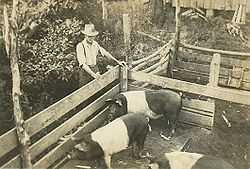Sty
- This article refers to an enclosure for raising pigs. Not to be confused with the eye disease stye and STY, an alternate socket name for GNU Screen. For the film by Pasolini, see Pigsty. For the television series, see Pig Sty.
| Look up sty in Wiktionary, the free dictionary. |
.JPG)


A sty or pigsty is a small-scale outdoor enclosure for raising domestic pigs. It is sometimes referred to as a hog pen, hog parlor, pigpen, pig parlor, or pig-cote. Pigsties are generally fenced areas of bare dirt and/or mud. Both "sty" and "pigpen" are used as derogatory descriptions of dirty, messy areas. There are three contributing reasons that pigs, generally clean animals, create such a living environment:
- Pigs are voracious eaters and will eat all the plants in the enclosure until there is nothing left to control erosion.
- The pig is a rooting animal and will dig for food in the enclosure, further disturbing the soil.
- Pigs do not regulate temperature by sweating[1] which means that they must be provided with water or mud in which they can control their own body temperature.
A large-scale enclosure for raising pigs is generally called a hog lot. Unlike a sty which would be found on a mixed farm, a hog lot is usually a dedicated facility.
Family farm hog pen

The family hog pen was a small-scale system of pig farming which is vastly different from the modern American hog farm. Modern intensive hog farms in the United States have an average of about 2,000 hogs, and large farms raise tens of thousands of hogs. Hog pens were found on family farms of the early 1900s, although backyard pig farming may still occur. In this article the words “hogs” and “pigs” are used interchangeably.
Family hog pens enclosed just a few hogs to provide year-round meat for the table. Prior to refrigeration, some family farms depended on pigs as a primary source of meat and shortening (lard) for year-round food. Farms which had tenant families might have several hog pens. A pigsty must have at least two pigs in it to be a pigsty.
The hog pen


Farming pigs outdoors poses a number of problems but the small scale of family farming made it possible to manage these problems. In particular, hogs suffer 'heat stress' in high temperatures and have no sweat glands to naturally cool themselves. To cool themselves hogs require access to water or a 'wallow', which is an area of mud. Without access to water or mud, pigs are forced to wallow in their own excrement. Normally, pigs avoid their own excrement; unlike other farm animals, pigs do not defecate just anywhere in their pen – they use one corner of it for their 'bathroom'. Ideally a cement wallow which contains water cools the pig much better, although mud serves to protect pink pigs from sunburn and heat stress, although more pigmented varieties were used on the family farm.. Alternatively, shade may be provided for the animals.
Many family farm hog pens were improvised enclosures made of any material that is handy and free. The size of the pen is often kept small to conserve building material and effort.
Slopping the hogs
Historically, these farms fed hogs grain, fruit and vegetables that are not fit for sale or family use. Overage produce from the farmer’s market and table and restaurant scraps were often diet elements as well. This practice of 'swill feeding' (feeding table scraps) is considered a disease risk today, though this is mainly associated with feeding pigs meat, which is banned in many countries. Hogs were also fed “slops” made from middlings or corn meal stirred with milk and water.
Historically, hogs were also allowed to forage in gardens and orchards after the harvest was over. Such foraging can cause erosion and runoff, but the small scale of these operations prevented this from occurring.
See also
- Aldred's Case
- Pig farming
- Pig slaughter
- Pig toilet
- Slaughter house
- St Fagans National History Museum
References
- ↑ Bracke, M.B.M. (June 2011). "Review of wallowing in pigs: Description of the behaviour and its motivational basis". Applied Animal Behaviour Science 132 (1): 1–13.
| |||||||||||||||||||||
